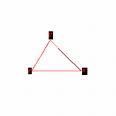Lines And Angles (Geometry) Quiz Questions
This quiz is designed as a review of Lines and Angles found in Geometry, it is based on 5th grade Ohio Content Standards.
- 1.
A Line Segment is defined as:
- A.
A straight path in a plane, extending in both directions with no endpints.
- B.
A part of a line; it begins at one endpoint and extends forever in one direction.
- C.
A part of a line between two endpoints.
Correct Answer
C. A part of a line between two endpoints.Explanation
The correct answer is "a part of a line between two endpoints." This definition accurately describes a line segment, which is a portion of a line that has two distinct endpoints. Unlike a line, which extends infinitely in both directions, a line segment has a finite length and is bounded by its two endpoints.Rate this question:
-
- 2.
A Ray in defined as:
- A.
A part of a line; it begins at one endpoint and extends forever in one direction.
- B.
A part of a line between two endpoints.
- C.
A straight path in a plane, extending in both directions with no endpoints.
Correct Answer
A. A part of a line; it begins at one endpoint and extends forever in one direction.Explanation
A ray is defined as a part of a line that starts at one endpoint and continues indefinitely in one direction. Unlike a line segment, a ray has no endpoint on the side it extends towards.Rate this question:
-
- 3.
A Right angle is:
- A.
A special angle formed by perpendicular lines and equal 90 degrees.
- B.
An angle that measures less than 90 degrees.
- C.
An angles whose measure is greater than 90 degrees but less than 180 degrees.
Correct Answer
A. A special angle formed by perpendicular lines and equal 90 degrees.Explanation
A right angle is a special angle formed by perpendicular lines and has a measure of 90 degrees. This means that when two lines intersect to form a right angle, the angle between them is exactly 90 degrees. It is different from angles that measure less than 90 degrees or angles that measure more than 90 degrees but less than 180 degrees.Rate this question:
-
- 4.
An Acute angle is:
- A.
An angle whose measures is greater than 90 degrees but less than 180 degrees.
- B.
An angle that measures less than 90 degrees.
- C.
An angles that is formed by perpendicular lines and equal 90 degrees.
Correct Answer
B. An angle that measures less than 90 degrees.Explanation
An acute angle is an angle that measures less than 90 degrees. This means that the angle is smaller than a right angle (which measures exactly 90 degrees) and does not extend past the halfway mark of a straight angle (which measures 180 degrees). Acute angles are typically associated with sharp or narrow corners and are commonly found in geometric shapes such as triangles.Rate this question:
-
- 5.
An Obtuse angle is:
- A.
An angle whose measure is greater than 90 degrees and less than 180 degrees.
- B.
An angle that measures less than 90 degrees.
- C.
An angle formed by perpendicular lines and is equal to 90 degrees.
Correct Answer
A. An angle whose measure is greater than 90 degrees and less than 180 degrees.Explanation
An obtuse angle is an angle that is greater than 90 degrees but less than 180 degrees. This means that it is wider than a right angle (90 degrees) but not as wide as a straight angle (180 degrees). An obtuse angle can be visualized as an angle that opens up more than a right angle, but not enough to form a straight line.Rate this question:
-
Quiz Review Timeline +
Our quizzes are rigorously reviewed, monitored and continuously updated by our expert board to maintain accuracy, relevance, and timeliness.
-
Current Version
-
Mar 22, 2022Quiz Edited by
ProProfs Editorial Team -
Dec 04, 2008Quiz Created by
Rasimone





